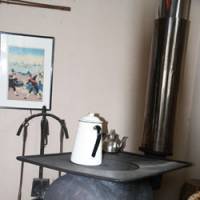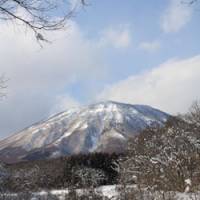A friend just sent me a satellite photograph taken last month of the whole of Britain blanketed in white, and wrote about the homeless folk dying in extremely cold weather in Poland. Perhaps some people will doubt that global warming is happening at all after this winter — little realizing that it should more correctly be termed "climate change."
Meanwhile, as I write this, through one of my study windows here in the Nagano Prefecture highlands I can see a snowy wood in front of me. Over my right shoulder, through another window, there's the icy Torii River, its banks obscured by a meter of snow. Snow is falling again, and Mount Kurohime (the great "Black Princess") on the horizon is obscured by gray-white cloud. It's bloody cold!
I am grateful indeed for the stove that my neighbor, Mr. Toya, made for me out of an old propane gas tank. It's in the room below me, where guests stay, but the chimney runs up through my study, radiating heat. It really is a great stove, with an air intake that is easily regulated, and it is big enough to take two or three large logs that then slowly burn for hours. It's the woodstove-best-stove I've had.
As I gaze out at this snowy scene from the warmth of my cozy den, my mind goes back to the winter of 1961-62 when, at the age of 21, I was the youngest overwintering member of the Arctic Institute of North America's Devon Island Expedition.
After we'd arrived on the island the previous summer, the previous winter's ice in Jones Sound, the only access route for ships, had melted so little and remained so thick that the icebreaker meant to deliver our supplies could not reach us. As a result, throughout that winter up in the High Arctic we were very short of fuel oil, and had no fresh food at all.
As a consequence we had to strictly ration our use of fuel, which meant that the sleeping hut went unheated even when outside temperatures were regularly dropping below minus 40 degrees.
Having lived with the Inuit for a short while on two previous expeditions, I knew that an igloo would be much warmer, so I built myself one — much to the derision of the four older members of the group, who mostly had Antarctic experience and had only read of Inuit ways.
A rather posh igloo it was too, because when the lake beside us froze over, I had cut a 15-cm thick pane of ice and stored it ready and waiting for there to be enough good, wind-packed snow to fit my private snowdome bedroom with a clear-ice window. The bed was a raised snow platform, on which I laid a groundsheet, then, luxury of luxuries, I spread the fluffy furry hide of one of the two polar bears that attacked our base camp at Christmas (and got shot by me). Upon this soft white rug I laid my eiderdown sleeping bag. We did have an ample supply of candles, so with one cheerily burning in the igloo, plus my own body heat, the temperature was typically as much as 30 degrees higher than it was outside. That was a lot warmer than the unheated sleeping hut!
There were land-locked char in the lake, so I kept a hole open over the deepest part, with an igloo built over it. Every four days, unless we were out traveling, I fished through that hole out in the middle of the lake and would always manage to catch enough fish to make a meal for all five of us.
The hole also saved fuel; every day we would take turns to haul a sled mounted with a 25-gallon steel drum out to it, break the fresh ice on the top, then dip buckets into the water and fill up the drum. Afterward, making sure its lid was tightly in place and the drum was firmly lashed and sealed, we'd haul it back to the living hut.
That main hut and our smaller science hut were heated with oil stoves. About 2 cm of ice would form on the inside of the drum by the time we got it back to the hut, but that still left plenty of fresh water, and we weren't taking showers! It takes a lot of heat to convert snow or ice to water, so although this was a lot of work, it did save plenty of fuel.
When the weather was reasonable, I would put on skis or snowshoes and hunt for Arctic hare. For Christmas, two fine fat snow geese fell to my .303 rifle just before they migrated south. Spencer Apollonio, our expedition leader, had banned me from shooting things except in self-defense. Fortunately, though, the other three members stood up for me when I claimed that the hares, and the geese, had attacked me with vicious intent. (Mind you, old Spence had no qualms of eating what I shot or caught — otherwise it would have been all dried foods and war-surplus U.S. Army C. rations). We also ate the polar bears. After all, it was better for the expedition that it wasn't us that got eaten.
Arctic expedition experiences, and having grown up in Britain during and after World War II, makes me very conscientious about not wasting food, and also about having enough food stored away ready for the worst that winter may come up with. And even though it is now only a 10-minute drive from my home here in the Kurohime woods to a wonderfully stocked supermarket, my way of thinking hasn't changed.
I have two large chest freezers packed with venison, wild boar and various organic meats. The freezers also hold diced, frozen parsnips and turnips, and several packets of frozen mountain vegetables that I picked in the wild and packed in spring, ready for winter use. There are sacks of potatoes in the basement, too, and I always have to watch out they don't freeze. Ditto, the wine in my well-stocked cellar.
Prior to the coming of snow, I imported an excellent food-dryer from the United States, and also, through television shopping, bought a device that vacuum packs food. As a result, lots of venison jerky, marinated in red wine before drying, gets stored in plastic vacuum packs. This prevents mold, and means it keeps well in a cool place. Boxes of windfall apples, which otherwise would have been dumped, also find their way to Old Nic's kitchen. There they are peeled and thinly sliced, then given a little soak in lime juice and water, which stops them from going brown. Then I dry these delicious apple chips, which are also easily stored in the cool basement in vacuum packs.
Each year from Rishiri Island, Hokkaido, I get a supply of freshly frozen spring kelp, which is very tasty and very good for you, but too thin to dry. This gets cooked in a big French pressure cooker, then minced to a paste in a food-processor, before being sealed in jars. A dab of this stuff goes marvelously well with hot rice, or in miso soup. These jars join the ranks of pickled gherkins and bottled tomatoes on a shelf in the basement.
Throughout the year we sun-dry shiitake and other woodland mushrooms. The food-dryer gets used to thoroughly dry the slimy yellow winter mushrooms which are harvested in great quantities in autumn. With a food-processor I turn these dried mushrooms into a powder that, when it is sealed in a jar, will pretty well last forever; great for soups, Western or miso, and for thickening stews. Rice (organic, of course) we buy in sacks. The only thing that seems to run out is the sake and shochu. Lord knows why.
I glance out of the study window again to see a flock of little long-tailed tits flitting from branch to branch in the very tops of the trees looking for insects that hibernate in the bark. A colorful pigmy woodpecker is doing its thing on the tree closest to me. I'm so glad they are out there and I'm in here. As I said, outside it's bloody cold, so may the woods be blessed for providing firewood — and Mr. Toya for making the stove!


















With your current subscription plan you can comment on stories. However, before writing your first comment, please create a display name in the Profile section of your subscriber account page.